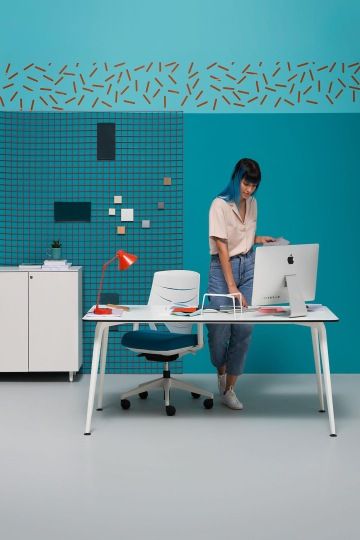Hybrid work: how the coronavirus is changing established ways of working

The coronavirus has forced companies around the world to look for new ways to organize their work. For many of them, a model that combines teleworking and office time is a conceivable future. How does hybrid work function in practice, what are its specifics and what effect does this arrangement have on the offices themselves?

Decision-making in times of lingering uncertainty
The current situation calls for alternative forms
of corporate communication, working hours and physical presence in offices. Some companies have allowed employees to continue working remotely until at least 2021, others have introduced staggered schedules and smaller work groups at the workplace. However, the persisting uncertainty about future developments has led to hybrid work, combining teleworking with office work.
The propensity for this model is also confirmed by a May study from Stanford, which shows that 55% of American workers want to combine work at home and in the office. According to our survey of the working environment in the Covid period, 38% of employees consider a combination of work from home and office to be the best in terms of productivity.
What does hybrid work look like now and what
will it look like?
The basic features of hybrid work include more autonomy in deciding where an employee wants to work at a given moment. It also requires employees to actively think about who they have to work with and when, who they have to meet in person, what affects their productivity and what they need to do. Hybrid work is certainly not synonymous with absolute freedom and flexibility.
The physical monitoring of the people in the team was replaced by task management. In practice, companies that have adopted
a hybrid approach often set hybrid days for meetings and collaborating in the office and remote days for work with an individual focus. Physical presence is suitable, for example, for:
- launching or completing projects
- hiring a new member and building the team
- synchronizing activities
- meetings with key partners and clients
Different perspectives on hybrid work

Nicholas Bloom, a professor of economics at Stanford University and a teleworker, estimates that people will work from home on average two days a week after the pandemic subsides. According to him, this setup is ideal for maintaining productivity and reducing commuting stress.

Marco Minervini, a researcher in organizational design at the INSEAD European business school, warns that a mixed model
can create a gap between office workers and home office people. According to him, hybrid work can potentially worsen the gender gap, because women are expected to take on housekeeping responsibilities.
Challenges of hybrid work
- Another negative can be associated with digital communication itself. Although people have learned to use remote communication tools, this does not eliminate communication problems altogether. Social barriers are stronger when working face
to face, and conflict is therefore more likely when communicating remotely. Another obstacle is the expression of emotions.
Petr Pouchý, an interaction designer from the Court of Moravia studio, says that using cards can help:
- Technical shortcomings and poor transmission quality also cause frustration. It is therefore crucial to adapt IT equipment to hybrid meetings. A participant connected remotely should not only be on the phone – they should also be visible. This is confirmed by Hana Pullová, Managing Partner at Jobs 2030:
Hana also points out another important element of hybrid work...
- Sound quality also goes hand in hand with image transmission. Although modern laptops are already equipped with a relatively high-quality microphone, investing in a suitable sound system (for example, built into the ceiling of the meeting room) clearly pays off. Jiří Plátek, Workplace Design Specialist at AV MEDIA, explains the possibilities:
- The goal of having a pleasant and productive meeting with a dispersed team is also supported by acoustics, lighting and other meeting room factors. Necessary adjustments, as revealed by Martin Židek, architect from CAPEXUS and co-author of the design
of T-Mobile offices.

You need to adapt
An effective hybrid workplace culture should allow people to work at different times, from different places and
at different paces. Minervini recommends dividing work into tasks that employees can perform independently and for which they can make quick decisions without the need for colleagues to be online at the same time. Hybrid work is about new procedures and approaches that you need to get accustomed to.



